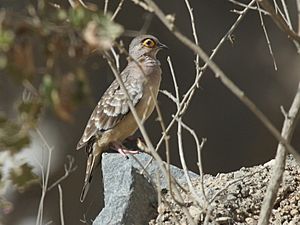Bare-faced ground dove facts for kids
Quick facts for kids Bare-faced ground dove |
|
|---|---|
 |
|
| Conservation status | |
| Scientific classification | |
| Genus: |
Metriopelia
|
| Species: |
ceciliae
|
 |
|
| Geographic range | |
| Synonyms | |
|
Gymnopelia ceciliae |
|
The bare-faced ground dove (Metriopelia ceciliae) is a type of bird that belongs to the Columbidae family, which includes doves and pigeons. You can find this bird in Argentina, Bolivia, Chile, and Peru.
Contents
How Scientists Classify the Bare-faced Ground Dove
Scientists group living things using a system called taxonomy. The bare-faced ground dove and its close relative, Moreno's ground dove (Metriopelia morenoi), were once placed in a different group called Gymnopelia.
Today, scientists recognize three main types, or subspecies, of the bare-faced ground dove:
- Metropelia ceciliae ceciliae (the main type)
- M. c. obsoleta
- M. c. zimmeri
However, some experts, like those at the Cornell Lab of Ornithology, think that M. c. obsoleta might not be a truly separate subspecies.
What Does the Bare-faced Ground Dove Look Like?
This dove is about 16 to 17 centimeters (6 to 7 inches) long. It weighs around 66 grams (2.3 ounces), which is about the same as a tennis ball.
The main type of bare-faced ground dove has brown or grayish-brown feathers on its back. These feathers often have white or light tips, making the bird look a bit spotted. Its neck and chest are gray with a hint of red or pink, and its belly is a light yellowish-brown color. The outer feathers of its tail are black with white tips.
A special feature is its eye. It's blue or bluish-white and surrounded by bare skin that can be yellow to orange. This bare skin is then framed by thin black feathers. Both male and female doves look very similar, though the female's chest might be less pink. Young doves look much like the adults.
The other subspecies have slight differences:
- M. c. obsoleta is usually paler and grayer.
- M. c. zimmeri is darker and browner, and its eye can be yellow to blue.
Where Bare-faced Ground Doves Live
Different types of bare-faced ground doves live in different places:
- The main subspecies, M. c. ceciliae, lives in western Peru.
- M. c. obsoleta is found in northern Peru.
- M. c. zimmeri lives in southern Peru, western Bolivia, northern Chile, and northwestern Argentina.
These doves prefer dry and semi-dry areas with sandy soil and not much plant life. In higher, treeless areas, they often live near people's homes. They are even common in big cities like Lima. They usually live at elevations between 2,000 and 4,500 meters (6,600 to 14,800 feet) high. However, in western Peru, they can be found much lower.
How Bare-faced Ground Doves Behave
What Do Bare-faced Ground Doves Eat?
Bare-faced ground doves are known to search for food on the ground. They usually do this in small groups. However, scientists haven't fully studied what they eat.
How Do Bare-faced Ground Doves Raise Their Young?
These doves build their nests on the ground, on cliffs, or sometimes in holes in buildings. Not much else is known about how they raise their chicks or their breeding habits.
What Sounds Do Bare-faced Ground Doves Make?
While their calls are not fully understood, bare-faced ground doves have been heard making a series of five similar cooing sounds. These sounds go up in pitch and then quickly go down. They also make a "Wo ow" sound, which some describe as a "growling wow."
Are Bare-faced Ground Doves Endangered?
The IUCN (International Union for Conservation of Nature) has evaluated the bare-faced ground dove. They have listed it as a species of "Least Concern." This means that the bird is not currently at risk of becoming endangered. It is considered common in most of the places where it lives. People's actions don't seem to have harmed this bird.
See also
 In Spanish: Paloma cascabelita para niños
In Spanish: Paloma cascabelita para niños


